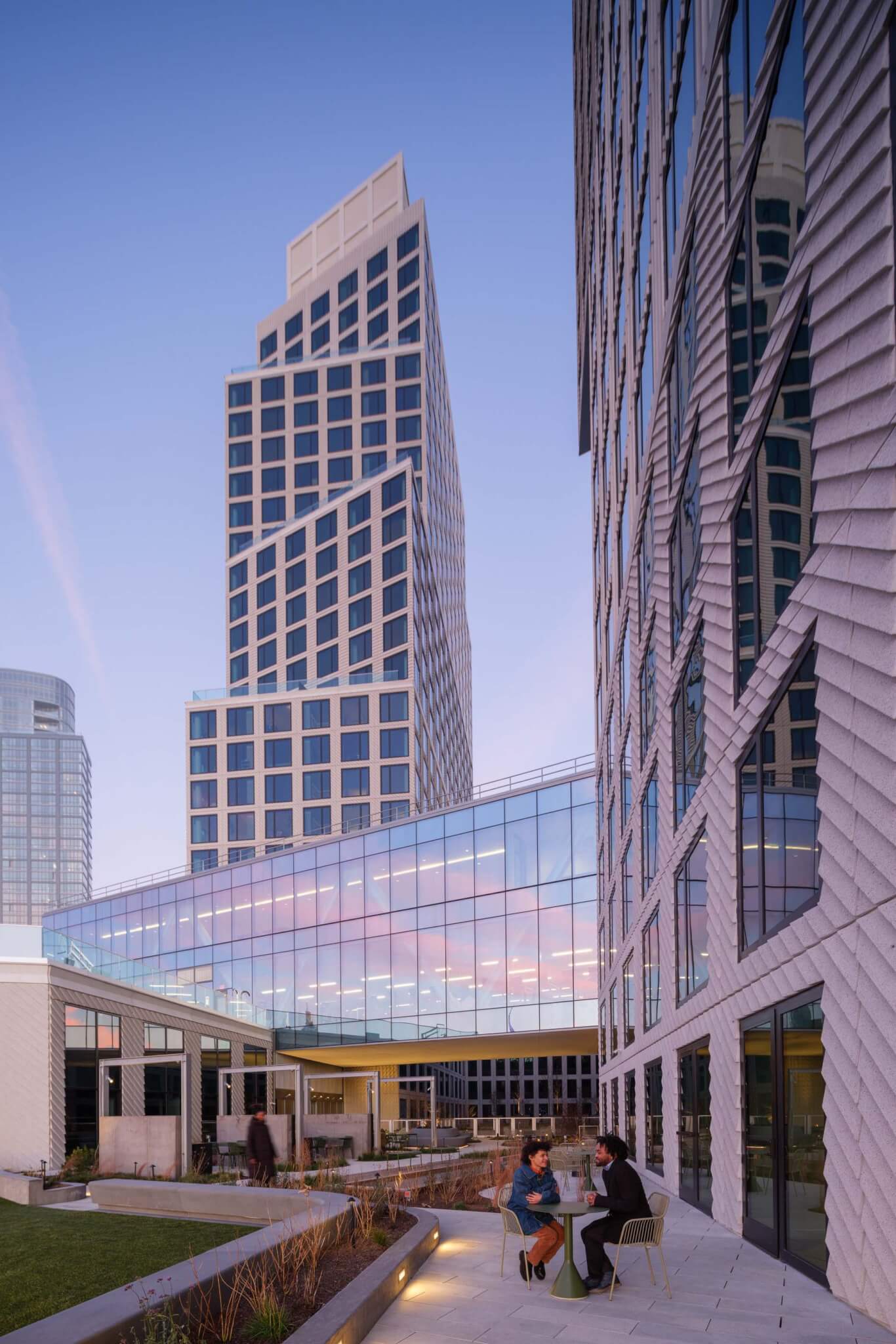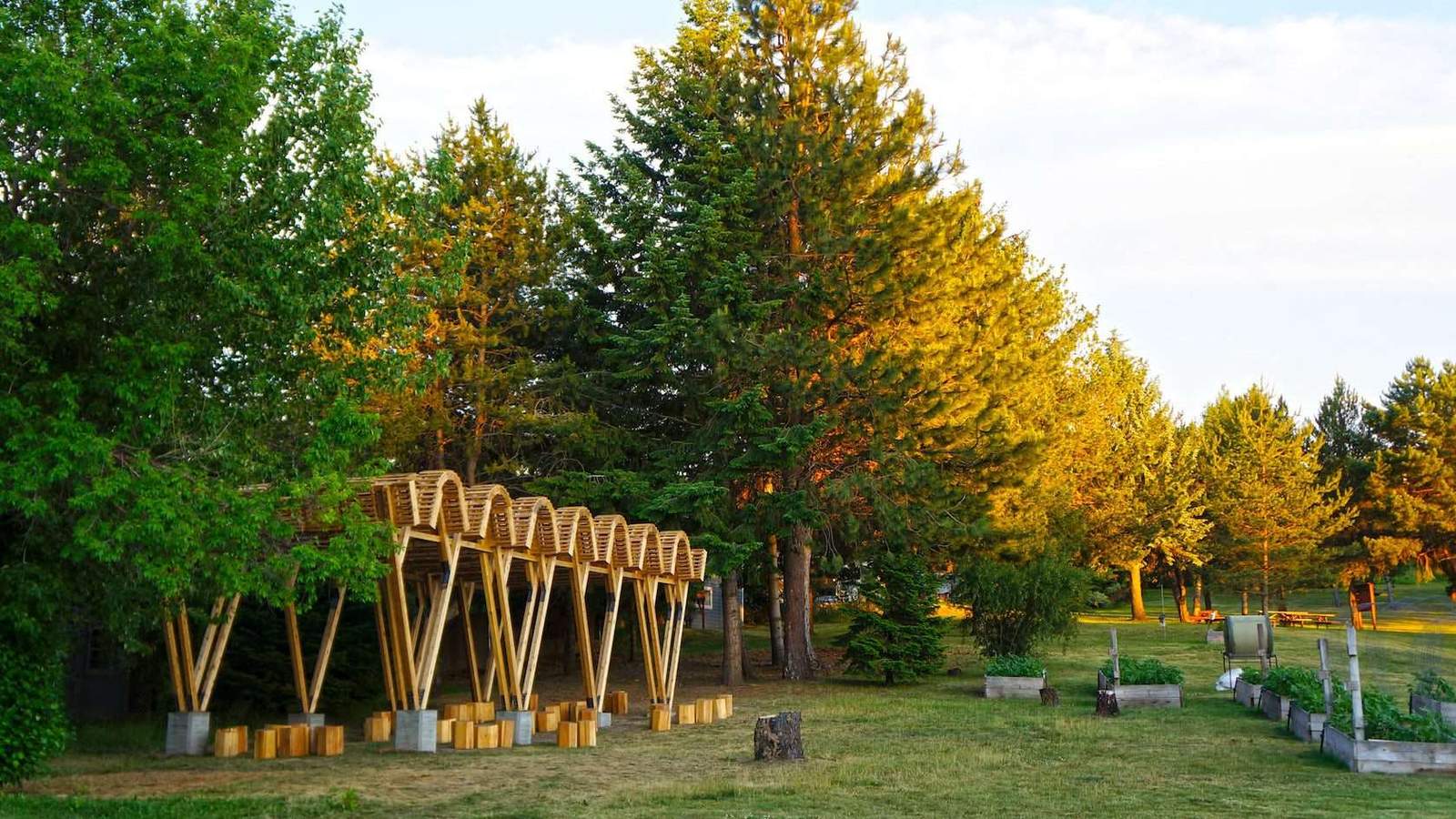New York City looms large in the OMA mythos, but the firm hasn’t had much success in building tall here. A first attempt came in the mid-1970s, when original cofounders Rem Koolhaas, Elia Zenghelis, and Zoe Zenghelis imagined a dense concentration of stepped and interlinked towers for Roosevelt Island (then Welfare Island). OMA’s local office, founded in 2001, has proposed its fair share of high-rises, from a teetering expansion for the old Whitney Museum to the Tetris-like 23 East 22nd Street. The fractal 121 East 22nd Street, completed in 2019 and largely a block-filler, failed to scratch the itch.
But Eagle + West, a new waterfront development in Greenpoint, does the trick. Sited where Newtown Creek empties into the East River and south of the Roosevelt Island plan submitted nearly 50 years ago, the complex comprises two towers set at a distance over a shared plinth. Unlike the precedents of stoic modernist ensembles—like I.M. Pei & Associates’ Silver Towers in Soho, say—the pair dances together: In a series of angled cuts, the waterfront building paces out while the interior building leans back. The parti establishes a kinship of sorts while jumping through various regulatory hoops. The smart scheme manipulates the maximum floor plate size of 11,000 square feet while expanding the distance between the facades from 40 feet to 60 feet, or approximately the width of a city street.

With its 432 Park–like square grid of dark apertures, the buildings are a welcome break from the plate-glass expanses that line both sides of the East River. From a distance (like speeding along FDR Drive), they read like thin twin towers, but on the eponymous West Street, they’re wide and substantial. Up close, what appears to be unified wholes are revealed to be piles of blocks, belted together every eight floors. At times the forms align into two rectangular pieces while at others the toothy interior profiles open—like a “broken cookie,” according to OMA New York Partner Jason Long—to reveal glimpses of Midtown beyond.

OMA’s work began in 2017 and was realized as part of larger urban changes. This section of Brooklyn was rezoned in 2005, with the waterfront changing from Manufacturing (M3-1) to Residential (R-6/R-8), and parcel massings step up in height from the neighborhood towards the water. In recent years, three residential buildings from Handel Architects and developer Brookfield Properties have appeared on the north side of Newton Creek. (One, the Bellslip, includes a nice lobby by Leong Leong.) To the south, construction is underway on The Huron, a 171-unit condominium by Morris Adjmi Architects. In between, trucks of all sizes and construction gear are stored on the open lots. The overall area is now called Greenpoint Landing.
Eagle + West’s 860,700 square feet are a strong addition to the profile of Brooklyn and to the state of high-density housing in the city. It reads like a single, contiguous megastructure, but it’s actually three buildings: the two towers (one 30 stories, the other 40) and a seven-story, L-shaped podium building. Entrances are marked by notches in plan. The top-heavy western tower, which steps out east with triangular paces, is structurally made possible by two sloping columns from which the floors below are suspended. The piers are diverted around a glazed amenity bar, which diagonally spans across the site.

The facade sets eight-foot-square windows within concrete panels cast with a simple shingled pattern. As seen in OMA New York’s recent book Search Term, the treatment was inspired by both Sol Lewitt’s drawings and the vinyl cladding of Greenpoint’s low-rise townhouses. Long explained that the panel manufacturer tolerated 2 inches of variable depth without serious issues, leading the architects to rotate this single pattern across the project. (In notched areas, the patterns “collide,” creating a two-directional fish-scale tile.) The windows were manufactured in Germany, shipped to Quebec, installed in prefabricated units, and trucked to Brooklyn. Up close, the texture sets shadows to work and continues the serrated trope down to the scale of the hand.

Los Angeles–based Marmol Radziner designed the shared interior spaces, imbuing them with a sense of warm California living. (The office also handled the landscaping in the interior courtyard.) Wood-lined boxes push back to the lobbies’ elevator cores; in the western one, they’re inlaid with ribbed stone, referencing the facade. In that same tower’s Great Room, white oak flooring and paneling plus a fireplace clad in stacked seafoam green Heath tiles establish a cozy feel. Outside, areas for relaxing and grilling are arranged in front of an in-progress wall of vines, trained to run at 45 degrees. Beyond an impressive party room (furnished with a large kitchen, long walnut table, and custom oversize light fixture), a coworking space, “adult playroom” (craft room), and kids’ room—complete with stroller parking—are included in the overall 42,000 square feet of amenities.

The swimming pool and exercise bar set like the bridge of a ship atop the lower floors is a nod to a classic OMA trope. In the appendix to Delirious New York, Koolhaas described a fictional scenario involving a seafaring swimming pool—“an enclave of purity in contaminated surroundings,” equal parts Moscow and Miami—that could serve as the basis for “a gradual program of improving the world through architecture.” Much as in that imagining, Eagle + West’s pool is a provocation. Its “ruthless simplicity” (to borrow one of Koolhaas’s phrases) can be seen in the exposed trusses, which chasten the implicit decadence. The workout zone is also, like, a sick place to get ripped.
The towers each rely on a double-loaded corridor to convey residents to their apartments. These interiors were handled by Beyer Blinder Belle, who was also the project’s executive architect. (Brookfield developed the project with Park Tower Group.) The units are smartly finished, and the picture-frame windows are pleasantly large for the rooms. OMA New York completed a residential tower with a curtain-wall facade in San Francisco while work was kicking off in Greenpoint; Long said they opted to move away from that treatment here to promote a greater feeling of domesticity by having some bits of exterior wall to nestle within. Some of the west-facing units have impressive balconies facing Manhattan, and one one-bedroom penthouse in the riverfront building sports a terrace that’s larger than the unit itself.

Eagle + West offers 745 apartments to a city desperate for more housing. Thirty percent are reserved as affordable (224 units), open to New Yorkers who make slightly less to more than the area’s average median income (AMI), roughly $85,000 to $133,500 for a couple. This means an affordable studio at 80 percent AMI will set you back $1,868 per month, while a market-rate studio starts around $3,500 per month with a 20-month lease, according to current online availability. Affordable units fully comprise the street-facing podium building and are mixed into the eastern tower, leaving the western one for full-price renters. The project’s design is well resolved, but it arrives during an unprecedented affordability crisis: New York recently became the most expensive city in the world, though the mayor recently announced a campaign to build 500,000 apartments in the next decade. It seems the city is in need of not just one new Eagle + West, but about 671 of them.
Part of the 2005 rezoning’s ambition was to re-establish waterfront access. Today, a wide path lines the bulkhead. When all the parcels in the area have been developed, the route will link up along the water, connecting sites like the WNYC Transmitter Park, Bushwick Inlet, and the 11-acre Marsha P. Johnson State Park in Williamsburg, renamed in 2020 for a gay liberation activist. The outer landscape—grassy and appropriately textural, with pines at regular intervals and young vines—was handled by Field Operations. Eagle + West’s first-floor units include a walk-out terrace set about 17 feet above sea level. Long said the elevation was to prevent flooding, both of the building and further into the neighborhood.

These days, it’s too easy to imagine a near-future reality in which an American acqua alta laps at the protective raised planters, stranding residents until low tide. Or, on a west-facing penthouse balcony above, a lucky tenant having their Caspar-David-Friedrich’s–Wanderer-above-the-Sea-of-Fog moment, standing Titanic-like at the glass guardrail overlooking a Manhattan skyline gone dark due to power outages. Or some eco-apocalyptic version of J.G. Ballard’s Highrise where residents of a single stacked block—the divisions are in part an attempt to demarcate smaller communities with the larger whole—band together to stake their claim for equal grill access. What once seemed impossible now feels within reach.

OMA is highly skilled at fulfilling a project’s brief while delivering an unexpected building that feels raw and smartly generic, nearly infrastructural. Its constructions—certainly those led by the New York office—are powered by research narratives that justify the resulting forms. They’re slightly reminiscent of “lorecore,” a portmanteau coined by Shumon Basar to describe our existential need to “storify ourselves.” The lifestyle goals embedded in the project arrive in an era of “endcore,” or Basar’s sense that things are going downhill fast. At Eagle + West—that is, at the conceptual intersection of lorecore and endcore—everything is nicely within reach: You can work out, WFH in the coworking lounge, read in the Great Room, have groceries delivered prior to cooking out on the deck, and relax upstairs while the sun plummets through the city’s canyons. Why leave at all?


